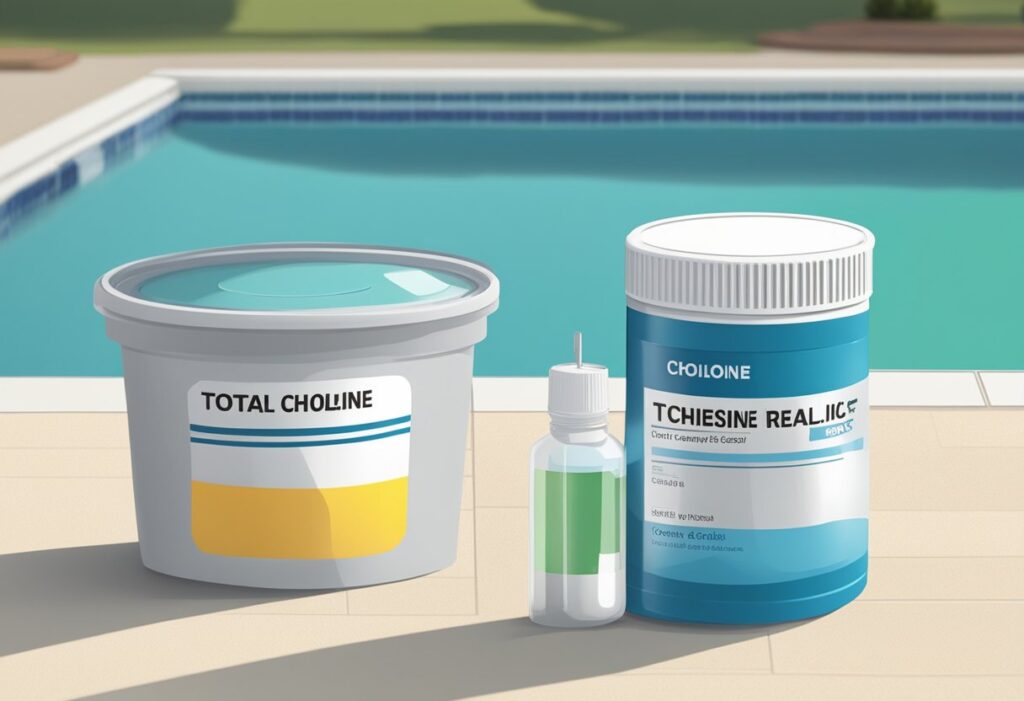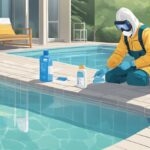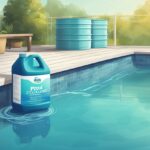Maintaining the water quality of your swimming pool is essential to ensure a safe and enjoyable swimming experience. Understanding the difference between total chlorine and free chlorine is fundamental to managing your pool’s chemistry. Free chlorine refers to the chlorine that is actively sanitising your pool, fighting off bacteria and other pathogens. It’s the chlorine that is available and unbound, ready to keep your water clean.

Total chlorine, on the other hand, encompasses both free chlorine and combined chlorine, which is the chlorine that has already reacted with contaminants in the water, such as sweat, oils, and urine. Combined chlorine is less effective at sanitation. It’s important that the level of free chlorine remains higher than combined chlorine to ensure your water remains disinfected.
The balance between free chlorine and total chlorine is key. If you find that the level of total chlorine exceeds that of free chlorine, it may be time to ‘shock’ your pool. This involves adding a large dose of chlorine to the water to breakdown the combined chlorine, effectively resetting the balance and restoring the sanitising power of your pool water. Monitoring and managing these levels is crucial for a clean, healthy swimming environment.
Understanding Chlorine in Pools
When you maintain a pool, it’s essential to grasp the different types of chlorine present and their specific roles in ensuring your pool remains free of contaminants and safe for swimming.
Defining Free, Combined, and Total Chlorine
Free Chlorine (FC): This is the chlorine that’s actively sanitising your pool. It’s unbound to contaminants, ready to take on bacteria and other pathogens. For effective sanitisation, a level of 1-3 ppm (parts per million) is commonly recommended.
Combined Chlorine (CC): After free chlorine interacts with ammonia or nitrogen compounds, it forms combined chlorine, also known as chloramines. These chloramines are less effective as disinfectants and can cause the characteristic “chlorine smell” as well as skin and eye irritation.
Total Chlorine (TC): This value is the sum of free chlorine and combined chlorine. It provides an overview of all types of chlorine present in your pool.
| Type of Chlorine | Descriptor | Usual Level in PPM |
|---|---|---|
| Free Chlorine | Actively sanitising | 1 – 3 |
| Combined Chlorine | Bound, less effective | Low as possible |
| Total Chlorine | Overall chlorine level | Depends on FC and CC |
The Role of Chlorine in Pool Sanitisation
Chlorine’s primary role in your pool is to sanitise or disinfect water by breaking down and neutralising harmful bacteria and contaminants. When free chlorine encounters these pathogens, it neutralises them, which is essential for preventing waterborne illnesses and maintaining a clean swimming environment.
Importance of Balanced Chlorine Levels
Maintaining balanced chlorine levels is critical. If the level of free chlorine is too low, your pool won’t be adequately sanitised and could become a breeding ground for bacteria. Conversely, if the total chlorine level is too high, it may indicate an excess of combined chlorine, leading to discomfort and potential irritation for swimmers. Regular testing and adjustments ensure that free chlorine remains effective and that the combined chlorine doesn’t reach levels that detract from pool enjoyment.
Measuring Chlorine Levels
Properly gauging your pool’s chlorine levels is essential for maintaining a healthy swimming environment. This requires an understanding of the different testing kits available, interpreting parts per million (PPM) measurements, and making sense of the results.
Types of Chlorine Testing Kits
Chlorine Test Strips: These are a quick method for checking chlorine levels. Simply dip a test strip into your pool water, and then compare the resulting colour change to the chart provided.
Liquid Test Kit: A more accurate method, liquid test kits involve adding a specified number of drops of a reagent to a sample of pool water. This produces a colour change that you can compare to a colour chart to determine chlorine levels.
Electronic Chlorine Tester: For a more tech-savvy and precise option, electronic testers can give you an instant digital reading of your pool’s chlorine content.
Drop Test Kit: Similarly to liquid test kits, drop test kits employ reagents that cause a colour change. They typically offer a high degree of accuracy and are a popular choice among pool owners.
Understanding PPM Measurements
Chlorine levels in your pool’s water are measured in parts per million (PPM). Your free chlorine levels—the active chlorine that sanitises your pool—should typically be between 2 to 3 PPM for optimal cleanliness and safety.
Interpreting Test Results
After testing your water:
- If the free chlorine and total chlorine levels are the same, your pool is correctly sanitised with no combined chlorine present.
- A higher total chlorine reading compared to the free chlorine indicates the presence of combined chlorine, which is less effective at sanitisation and may require you to ‘shock’ your pool.
You must also consider the impact of a saltwater chlorine generator, if present, as it continuously adds chlorine to the pool and may influence your readings. Always follow the manufacturer’s guidelines for your specific test kit to ensure accurate results.
Maintaining Proper Chlorine Levels
Achieving the right chlorine levels is crucial for a healthy and safe swimming environment. Here’s how you can maintain ideal chlorine levels through regular maintenance, periodic shocking, and managing CYA levels.
Regular Pool Maintenance
You should consistently test for free chlorine to maintain a level between 1-3 ppm (parts per million) in your swimming pool. Regularly test and adjust the pH level to the optimal range of 7.2 to 7.8, as this affects chlorine efficacy. Also, keep an eye on the total alkalinity, which should be between 80 to 120 ppm, to ensure optimal water balance and chlorine performance.
- Checklist for Regular Maintenance:
- Test free chlorine: aim for 1-3 ppm.
- Adjust pH level: maintain within 7.2 to 7.8.
- Monitor total alkalinity: keep within 80-120 ppm.
Shocking the Pool
Occasionally, your pool will require a shock treatment to raise the chlorine level quickly, which can effectively kill bacteria and algae. To shock your pool, add a large dose of chlorine—either in the form of chlorine shock or non-chlorine alternatives. This process should be done at dusk or during the night as UV light can degrade the chlorine.
- Steps for Shocking Your Pool:
- Perform at dusk or night.
- Add chlorine shock per manufacturer’s instructions.
- Allow the chlorine levels to return to 1-3 ppm before swimming.
Managing CYA and Chlorine Balance
Cyanuric acid (CYA), or pool stabilizer, protects chlorine from UV degradation. However, the right balance is key; too much CYA can reduce chlorine’s effectiveness. Aim to keep CYA levels between 30-50 ppm for outdoor pools. Adjust your chlorine additions according to the stabilizer level, ensuring that your pool chemistry remains balanced for safe swimming.
- Cyanuric Acid Guidelines:
- Maintain CYA levels between 30-50 ppm for outdoor pools.
- Balance chlorine addition with CYA levels.
By following these specific maintenance routines, you can ensure your pool’s chlorine levels are properly managed for a safe and enjoyable swimming experience. Remember to regularly test your water, shock when necessary, and balance your CYA to sustain perfect swimming pool chemistry.











